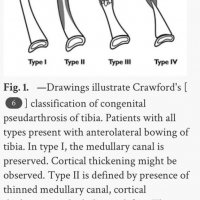CONGENITAL PSEUDARTHROSIS OF THE TIBIA (CPT)
Congenital pseudarthrosis of the tibia (CPT) refers to nonunion of a tibial fracture that develops spontaneously or after a minor trauma. It is a rare pathology, occurring in only 1 out of 250,000 births. The cause of CPT is currently unknown; however, there is a strong association with neurofibromatosis in 50% of cases and an association with fibrous dysplasia in 10% of cases. The pseudarthrosis usually develops within the first two years of life; but may be undetected up to the age of 12 years. Bilateral occurence is rare; the fibula is affected in one third of the patients.
Congenital tibial pseudoarthrosis is characterized by segmental osseous weakness, resulting in anterolateral angulation of the bone. Reports indicate the pathologic processes of CPT are linked to the periosteum, which forms the outer layer of bones and is crucial for regrowth following a fracture. Patients with CPT have a thick scar layer surrounding their bones rather than the periosteum. For this reason, once a fracture has occurred it will not heal spontaneously.
Classification systems describing prognostic radiographic characteristics, natural history, onset, mobility, therapeutic guidelines, and variables influencing the outcomes have been proposed by many different authors. Three classifications of CPT are commonly used. The Andersen classification differentiates the morphology of pseudoarthrosis as dysplastic, cystic, or sclerotic types, in addition to a clubfoot type that arises because of accompanying abnormalities. Crawford described four types of CPT, all types have in common an anterolateral bowing of the affected tibia. The classification of pseudoarthrosis by Boyd consists of six types and includes a type V, which is characterized by a complementary dysplastic fibula and a type VI, in which an intraosseous neurofibroma or schwannoma is evident.
While many classification systems exists, the most important criterion is the status of the tibia (fractured versus intact). Treatment is mainly surgical, with bracing used to supplement surgical procedures.







